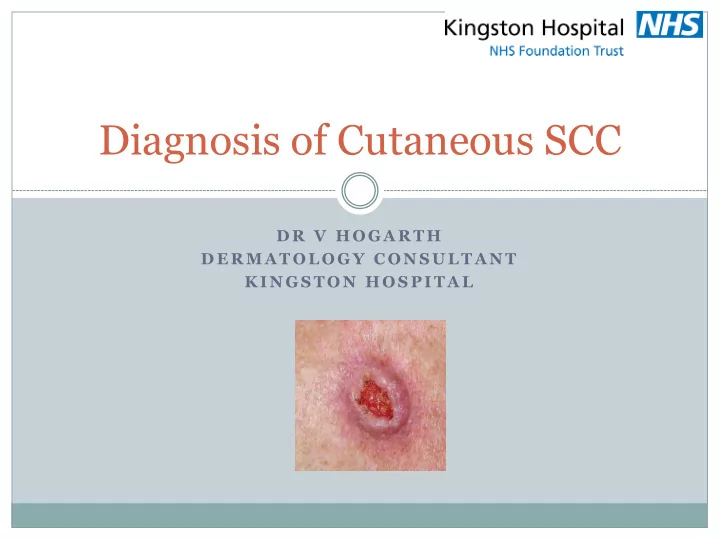

Diagnosis of Cutaneous SCC D R V H O G A R T H D E R M A T O L O G Y C O N S U L T A N T K I N G S T O N H O S P I T A L
INTRODUCTION Aim : Increased confidence screening for SCC Encourage follow up care in the community especially for low risk tumours Diagnosis 1. 2. Management Follow up/Screening 3.
Importance of SCC’s NMSC is the most common group of cancers 1. 2. 23% of these are SCC’s Continuing increase in prevalence 3. 4. Cancer of cells producing keratin May metastasise so treat early 5.
Risk factors
Immunosuppression HIV Immunosuppressive drugs Blood malignancies Organ transplant Receiving radiation These are more aggressive and greater risk of metastasis Previous cutaneous injury – longstanding ulcer/thermal injury
History Varies Enlarging over weeks to months Rapidly growing with pain and tenderness Pain is important because it can indicate perineural invasion
Examination Size Location ?recurrent ?connected to underlying structures Borders – well/poorly defined ?evidence of previous surgery Lymph nodes Full skin examination
Location Within a background of sun-damaged skin Sun exposed sites Bald scalp 1. 2. Face 3. Neck 4. Extensor forearms 5. Dorsal hands 6. Shin
Size and colour variable A few mm Several cm Flesh coloured Erythematous
Initially thickening of skin and becomes an indurated plaque
Papulonodular Gradually becomes fixed and nodular
Papulonodular
Keratin/’Crater’ Margin firm and more raised than a basal cell carcinoma, often everted and irregular
Plaque like
Surface can be • Crusted Eroded • • Ulcerated
Warty/keratin horn
Poorly differentiated
Arising within ulcers
High risk features Ears, lips, genitalia and other mucosal sites Greater than 2cm Tumour thickness greater than 4mm Moderate or poorly differentiation Perineural invasion Recurrent Arising form a scar or ulcer Lymphovascular invasion Immunosuppression
Thank you
Risk factors UV radiation – SCC relate to chronic exposure (outdoor occupation/recreation) Sun – lived abroad>holidays Sunbeds Fair skin, red hair, blue eyes Family history Immunosuppression (HIV, drugs, blood malignancies, organ transplant, receiving radiation) BCC/AK’s Smoking Previous cutaneous injury – longstanding ulcer/thermal injury
Examination A Less commonly plaque-like or warty Can be hyperkeratotic with thick crust Secondary changes include erosions and ulceration
Recommend
More recommend